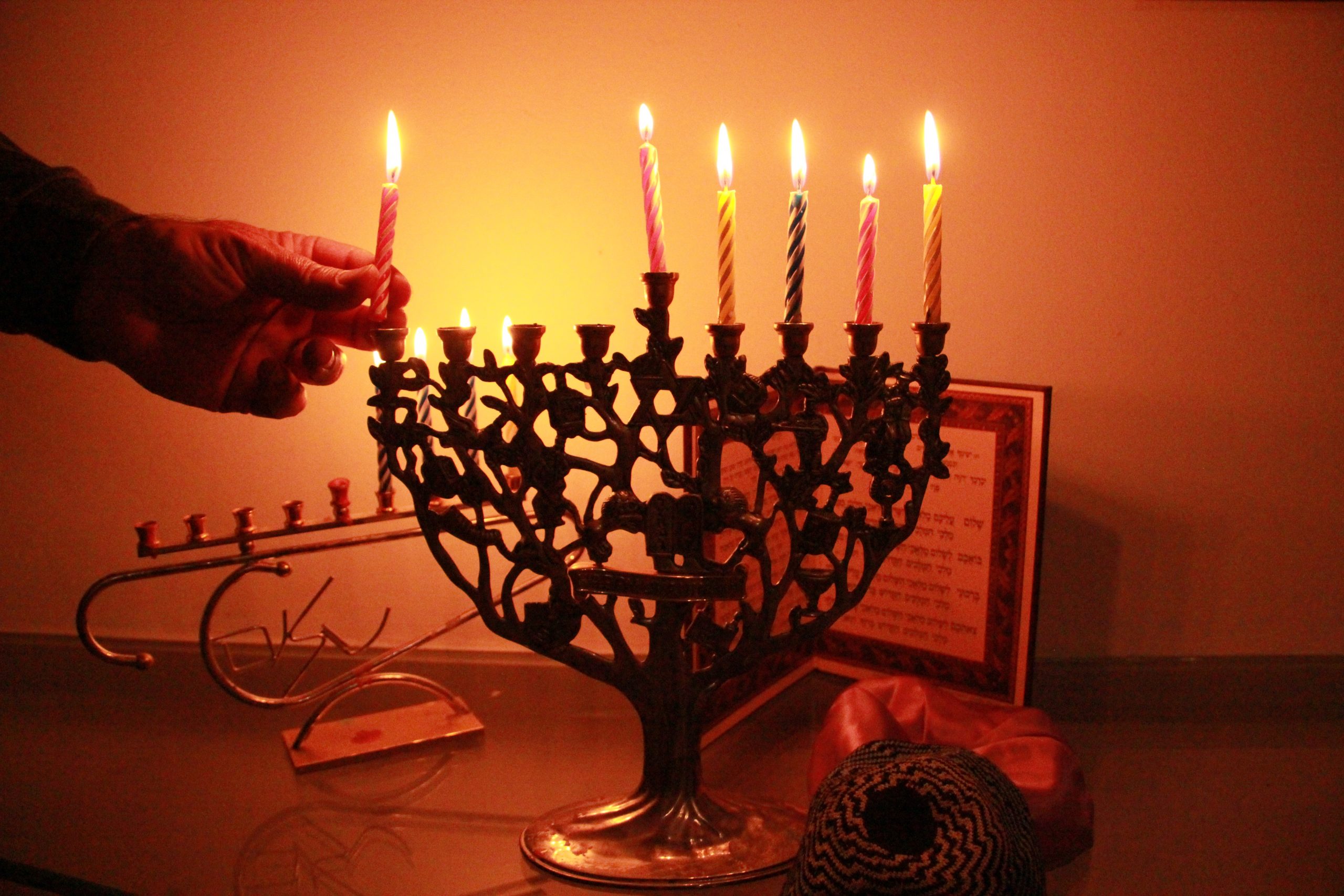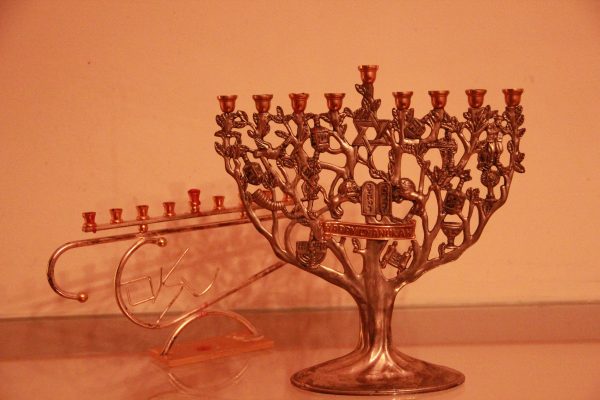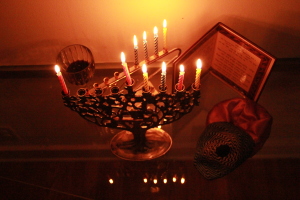

PHOTO BY NADIA DELJOU | THE SIGNAL
As the new Gregorian year approaches, three quarters of Americans will stroll through their local communities to find their religious traditions mimicked. Jingle Bell Rock and Winter Wonderland have already begun to saturate the frigid air, warming it with a traditional charm.
The other quarter will drive through their neighborhoods just like any other time of year, the difference being sequential lights that accentuate to create skeletons at night. Passing these and the occasional infant Jesus, five to eight million American Jews are wished a “Merry Christmas” despite the fact that their coinciding holiday is Hanukkah. Hopefully, they appreciate the good sentiment.
A Light in the Dark
Ari Solomon, 21, has undoubtedly received such a wish. He was raised Jewish and continues to celebrate Hanukkah every winter.

“We light the menorah all eight nights,” Solomon said. “I know a lot of families will give presents every night. Usually, if my parents are in a good mood, me and my siblings will each get one present apiece. It really depends on if we actually need anything.”
The menorah is a nine-branched candlestick—eight candles for each day of Hanukkah and a central candle, the shamash, to light the others. A widespread symbol of Judaism, the menorah has a somewhat obscure history. Solomon explains how the menorah earned its place among central Jewish relics, recounting violence between a small Jewish rebellion and the invading Seleucid Empire—champions of Hellenistic culture.
“So, the Maccabees, the Jewish rebels, rebelled and overcame them against all odds,” explains Solomon.
“And when they got to the temple, the Holy Temple, they found that it was desecrated. The oil for the Menorah has to have a certain seal on it, so they found one jar left—enough to last one night,” he described. “The Jews lit the Menorah and it lasted eight nights. So nowadays we light the Menorah for eight nights to commemorate that.”
Hanukkah, sometimes called The Festival of Lights, does celebrate the vitality of an insufficient oil supply but more importantly affirms the miraculous and resilient vitality of the Jewish People. The candles illuminate surroundings and each other —a beacon of life in the dead of night.
Immortal Culture
While Christmas cuisine includes eggnog and roasted turkey, Hanukkah has its own brand of festive recipes. Solomon describes the foods common in his home on Hanukkah.
“We also make the traditional foods like the latkes (potato pancakes) and sufganiyot which are the jelly donuts,” explains Solomon. “My mom at least makes the latkes homemade; sufganiyot, not always. She also buys for us large bags of chocolate gelt and expects us to play dreidel for them, but we have kind of grown out of that.”
Dreidel, another Hanukkah tradition, resembles innocuous gambling in which gelt (chocolate candy coins) replaces money. The dreidel is a spinning top with four sides, each of which is marked with a different Hebrew letter: Nun, Gimel, Hey and Shin. The purpose of the game is to reap the pot of gold that is chocolate, although as Solomon mentioned, spinning tops and chocolate coins seem more alluring at a young age. The love of chocolate, however, is notably chronic.
The holiday season sees the expression of culture in many ways—lines at the shopping mall to sit in Santa’s lap and make requests coincide with humble, religious services and prayer. The former seems superficial compared to the latter and has garnered accusations of materialism and vanity on Christmas, a holiday with humble roots. Hanukkah does not elude this blemish, but both holidays have reached a fork in the road: culture diverges from spirituality and manifests as seemingly absurd traditions.
Where spirituality requires introspection, tradition does not. For Solomon, Hanukkah is tradition-focused. He notes other Jewish holidays that entail sacrifice and self-reflection.
“I’d say [Hanukkah] is more of a traditional one,” said Solomon. “This holiday is not so heavily spiritual like other holidays; for example, Yom Kippur. You have to fast for 25 hours, you can’t wear leather shoes, you can’t bathe, you can’t use any oils. There’s a lot of stuff you can’t do because it’s supposed to be your spirit versus God.”
Yom Kippur is a Hebrew phrase meaning “Day of Atonement.” As this suggests, Yom Kippur is an ascetic holiday, a kind of cleansing. It is similar to the Sacrament of Penance in Catholicism in which confessions of wrongdoing are the first step towards reparation.
As in many religions, levels of observance vary. More “old-school” Jews are inclined to adhere rigidly to traditional sacrifices while the majority of American Jews are more open to changes in tradition and less bound to ritual concessions. This discrepancy creates distinguished denominations, or sects, within Judaism. Solomon sees these divisions as a challenge to strength and unity.
“I feel like it doesn’t lead to one strong community,” Solomon explains. “It leads to a lot of smaller communities, which may be strong on their own, but I feel that one big, strong one is the ideal.”
Strength in Strata
The diversity of observance within Judaism confounds any universal Jewish ideology. This has a wormhole of implications, namely that Judaism is difficult if not impossible to define. How then can Jews identify as Jews with confidence?
Solomon acknowledges this confusion and explains the ambiguity of Jewish ethics.
“It’s open to interpretation, I’d say,” Solomon explains. “Back in the day, you had rabbis and Jewish leaders arguing about what certain Jewish laws are–what sort of morals we have. And they came to conclusions, but the answer is, in modern application at least, there’s no one definitive answer for any question.”
Many religious traditions are driven by simple answers to complicated questions, breeding controversy and, historically, bloodshed. As Solomon reveals, Judaism’s ambiguity may be its greatest asset.
“I think that’s a way to reduce segregation and bickering,” Solomon notes. “Let’s say I believe in moral A. You may not completely agree with it, but we don’t argue about it. We each have our own interpretation of it.”
Judaism is as mysterious to outsiders as it is to Jews themselves. It may be troubling to stand so firmly with such weak footing, but the Jewish people have been doing it for three and half millennia—they are no closer to plunging towards the fertile dust from which they came.
